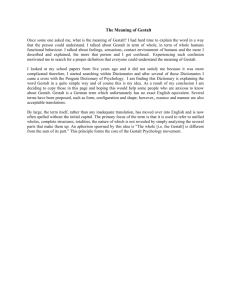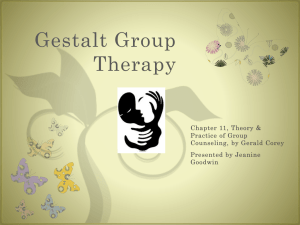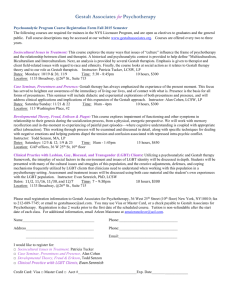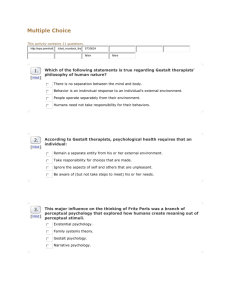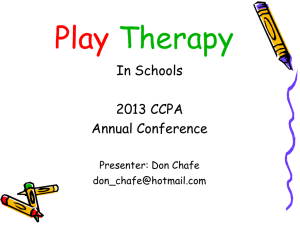Que sçay-je? / Que sais-je? - Gestalt International Study Center
advertisement
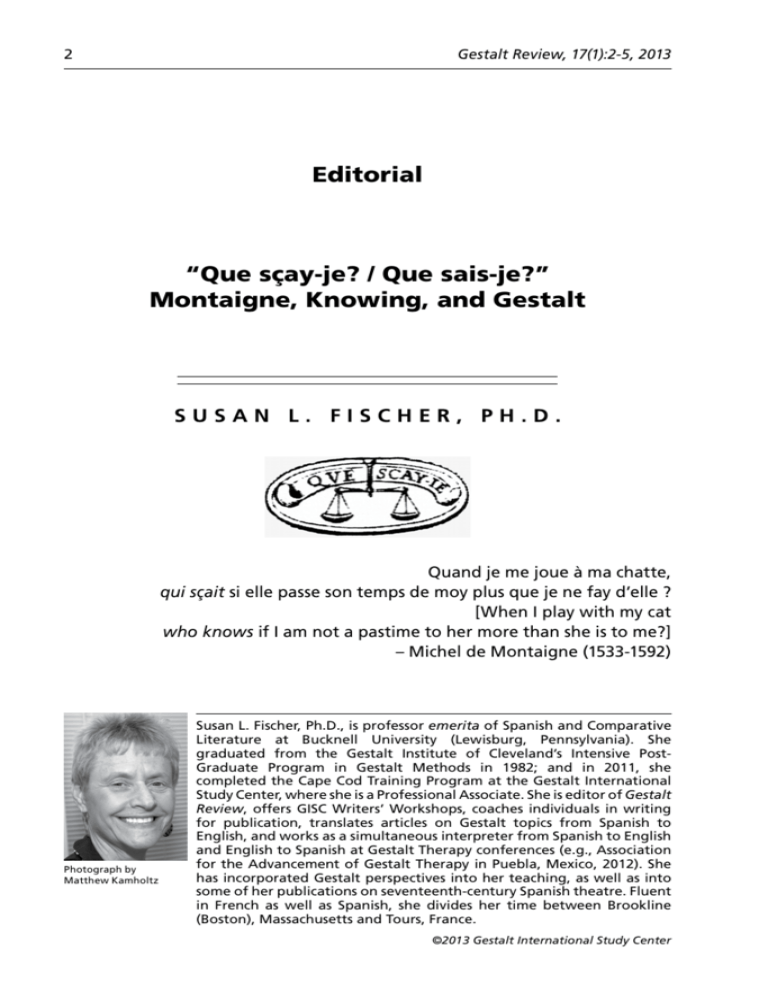
2 Gestalt Review, 17(1):2-5, 2013 Editorial “Que sçay-je? / Que sais-je?” Montaigne, Knowing, and Gestalt SUSAN L. FISCHER, PH.D. Quand je me joue à ma chatte, qui sçait si elle passe son temps de moy plus que je ne fay d’elle ? [When I play with my cat who knows if I am not a pastime to her more than she is to me?] – Michel de Montaigne (1533-1592) Photograph by Matthew Kamholtz Susan L. Fischer, Ph.D., is professor emerita of Spanish and Comparative Literature at Bucknell University (Lewisburg, Pennsylvania). She graduated from the Gestalt Institute of Cleveland’s Intensive PostGraduate Program in Gestalt Methods in 1982; and in 2011, she completed the Cape Cod Training Program at the Gestalt International Study Center, where she is a Professional Associate. She is editor of Gestalt Review, offers GISC Writers’ Workshops, coaches individuals in writing for publication, translates articles on Gestalt topics from Spanish to English, and works as a simultaneous interpreter from Spanish to English and English to Spanish at Gestalt Therapy conferences (e.g., Association for the Advancement of Gestalt Therapy in Puebla, Mexico, 2012). She has incorporated Gestalt perspectives into her teaching, as well as into some of her publications on seventeenth-century Spanish theatre. Fluent in French as well as Spanish, she divides her time between Brookline (Boston), Massachusetts and Tours, France. ©2013 Gestalt International Study Center SUSAN FISCHER 3 In 1576, the French essayist, Michel de Montaigne chose as his maxim of skepticism1 the question “Que sçay-je?” [What do I know?], which he had set on a personal medallion together with the Greek word epokhe [I hold back, or I reserve judgment], and on a pair of scales to remind himself of the potential equality of strength of two opposing arguments. For Montaigne, our “natural and original malady” is that of presumption; in his long essay, “Apologie de Raimond Sebond”(1580 / 1595), he develops that notion by borrowing the cat’s point of view: How does he [Man] know, by the force of his intelligence, the secret internal stirrings of animals? By what comparison between them and us does he infer the stupidity that he attributes to them? When I play with my cat who knows if I am not a pastime to her more than she is to me? We entertain each other with reciprocal monkey tricks. If I have my time to begin or to refuse, so has she hers. (Book II, chap. 12, p. 401)2 If, upon perusing this issue of Gestalt Review, Gestaltists were to follow the example of Montaigne and adopt as their maxim “Que sçay-je?” (or “Que sais-je?” in modern French), chances are that they would not be thinking of a series of books published by the Presses Universitaires de France, whose aim it is to provide the reader with an accessible overview of an area of study written by an expert in the field. (The series numbers more than 3900 titles by more than 2500 authors and has been translated into 43 languages since its inception in 1941.) Rather, the interest of Gestaltists might be sparked by Stephanie Sabar’s article entitled, “What’s a Gestalt,” which could arguably be counted among the fifty or sixty new titles added annually in the “Que saisje?” series. Sabar explores the history of this concept, tracing its etymology, its development in Gestalt philosophy and Gestalt psychology, and finally its application to clinical practice in Gestalt therapy. She describes it in terms of nine different Gestalt qualities which, when illustrated by concrete examples, can lead us to determine what we really “know” about the meaning of the word. The other articles and reviews in this issue of Gestalt Review ask us to tackle the field from different perspectives; Montaigne’s mission of counterbalancing 1 In the rebirth of skepticism attributed to Montaigne in the 16th century, reason and observation were the very things a skeptic was most likely to be skeptical about, yet one could still be devout. Simply put, skepticism was for Montaigne the opposite of dogmatism. 2 [La presomption est nostre maladie naturelle et originelle. . . . Comment cognoit il, par l’effort de son intelligence, les branles internes et secrets des animaux? par quelle comparaison d’eux à nous conclud il la bestise qu’il leur attribue? Quand je me joue à ma chatte, qui sçait si elle passe son temps de moy plus que je ne fay d’elle. Nous nous entretenons de singeries reciproques. Si j’ay mon heure de commencer ou de refuser, aussi à elle la sienne (p. 452).] 4 EDITORIAL a single opinion by taking into account other opinions is acquitted admirably.3 Katerina Siampani’s exhortation to Gestaltists to incorporate Sandplay therapy into Gestalt therapy in the treatment of dementia is based on clinical experience and observations which indicate that a direct intervention of this sort can mobilize patients at the initial or advanced stages of the condition. She provides a number of concrete case examples that show, for example, how Sandplay “releases creativity, intimate feelings, beliefs, and memories, bringing them to the external reality, where they may be indisputably witnessed.” Bruce Kenofer’s overview of Kegan’s subject-object theory highlights points of connection between developmental theory and concepts from Gestalt therapy, given the “lack of a Gestalt developmental theory” which purportedly limits the elucidation of the vital concept of the Self and invites dialogue on the subject. Nancy Amendt-Lyon’s commentary on Frank-M. Staemmler’s book, Empathy in Psychotherapy: How Therapists and Clients Understand Each Other, underlines the author’s three-pronged critique of “the characteristics of onesidedness, disembodiment, and individualism” as part of the overall question of whether “the subjective experience of another human being [will] ever be anything but an enigma,” or whether it can “be unveiled.” Amendt-Lyon, for her part, adds to the comprehensive reference list of scientific precursors to a modern concept of empathy cited by Staemmler two more psychoanalytic contributions: those of coenesthetic perception and resonance identification. Robert Farrand’s reading of Gestalt Therapy: Advances in Theory and Practice, edited by Talia Bar-Yoseph Levine, is virtually a mini-article in itself. It divides the discussion of the volume’s fifteen chapters into sections on critiquing Gestalt therapy; accounting for practice; field; and vulnerability. Farrands frames the review by positing that the book poses important questions on the relationship between practice and theory – “How does theory support good practice? Can current theory be holding back the development of Gestalt therapy?” – and he concludes provocatively with some of Philip Lichtenberg’s ambiguity: “Is current theory helping practitioners patch a leaking boat or build a new one?” The subtitle given by Margherita Spagnuolo Lobb to her reflective tribute to Daniel N. Stern (1934-2012) – “He Confirmed Gestalt therapy as an 3 See, for example, Montaigne’s assertion: “Many times (as I sometimes do deliberately), having undertaken as exercise and sport to maintain an opinion contrary to my own, my mind, applying itself and turning in that direction, attaches me to it so firmly that I can no longer find the reason for my former opinion, and I abandon it” (2003, p. 517). [Maintes-fois (comme il m’advient de faire volontiers) ayant pris pour exercice et pour esbat à maintenir une contraire opinion à la mienne, mon esprit, s’applicant et tournant de ce costé là, m’y attache si bien que je ne trouve plus la raison de mon premier advis, et m’en despars” (1962, p. 566).] SUSAN FISCHER 5 Outsider” – itself confirms the openness of Gestalt theorists and practitioners to examining individually and collectively what they “know” about the wider field of Gestalt. Spanguolo Lobb’s concluding words on Stern bring us full circle to Montaigne’s maxim of “Que sçay-je?” in that they imply a healthy combination of tolerance and skepticism: “His work has served as a bridging and integrating function in furthering our understanding of clinical theory, practice, and development, and his language has unified psychotherapists of different modalities, who consider his theory inspiring and vitalizing in order to get that ‘something more’ out of our art.” Finally, Frank Rubenfeld’s brief rumination on “Authenticity and the Pursuit of Happiness” serves as an apposite coda to this corpus of contributions. As a last word, and in the spirit of Montaigne, I invite all and sundry to reflect upon the level of mutual awareness and experimentation that may be present in “playful” interactions with the purring and meowing species. Susan L. Fischer, Ph.D. sfischer@bucknell.edu Photograph by Judy Robertson REFERENCES Montaigne, M. (1962). Apologie de Raimond Sebond. Oeuvres complètes (Book II, chap. 12). (Eds. A. Thibaudet & M. Rat). Paris: Gallimard. (Original work published 1580 / 1595) Montaigne, M. (2003). The Complete Essays. (D. Frame, Trans.). New York: Alfred A. Knopf.
